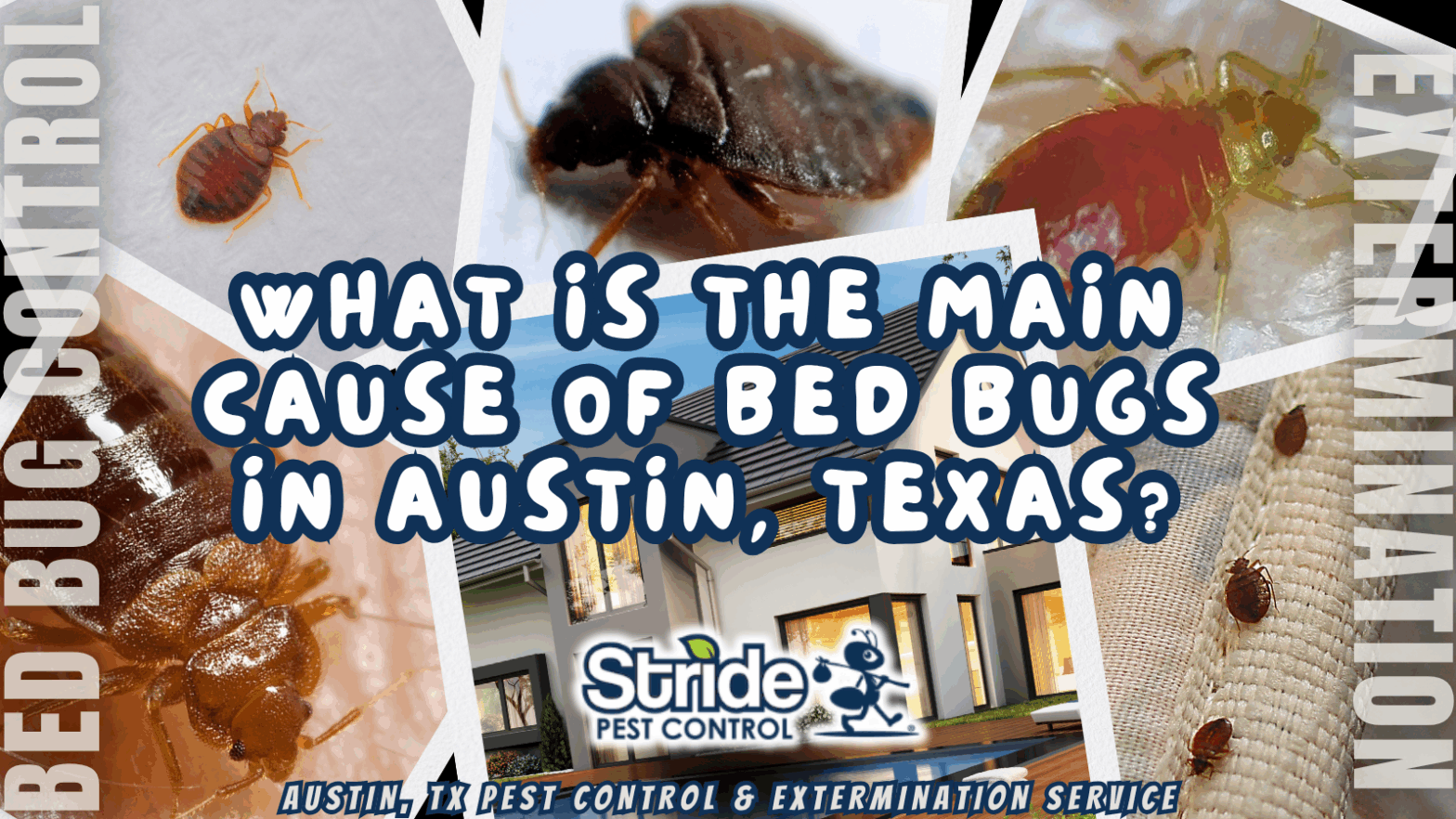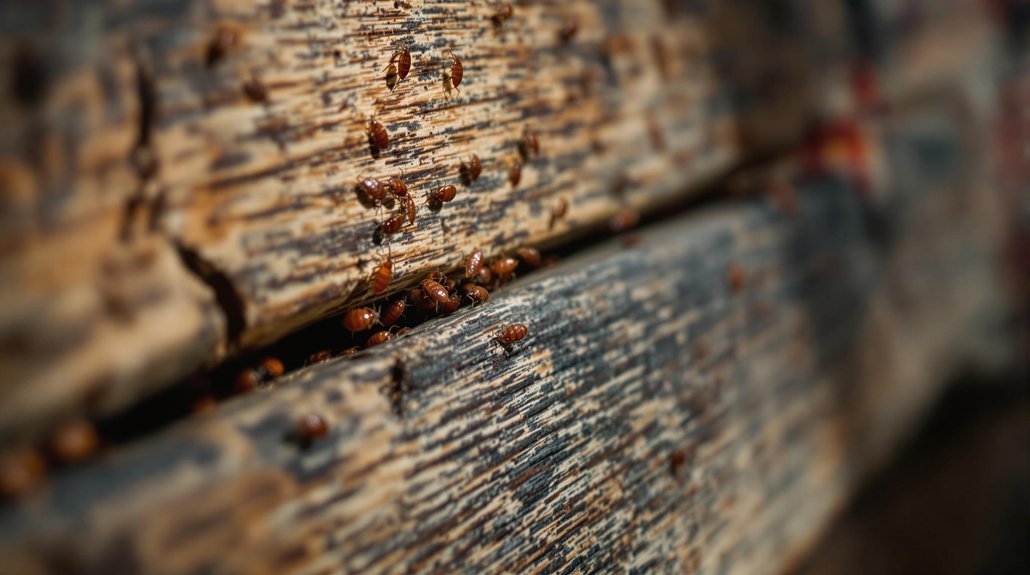
The main cause of bed bugs in Austin, Texas, is increased travel and urban living. Many people unknowingly bring bugs home from hotels, airports, or visiting friends. Dense apartment buildings also help the pests spread quickly. Plus, the rise in used furniture sales can carry bed bugs into homes. Climate and seasonal changes make the pests more active. For details on how to prevent and manage this, keep exploring further.
Key Article Highlights
- Increased international travel brings bed bugs into Austin via luggage and personal belongings.
- High urban density in apartments facilitates the spread between units and common areas.
- Use of secondhand furniture without proper inspection introduces bed bugs into homes.
- Limited public awareness hampers prevention and early detection efforts.
- Seasonal factors like warmer months and high guest turnover in hotels accelerate infestations.
Increased International Travel and Tourism

One of the main reasons for the rise in bed bug cases in Austin is the increase in international tourism and travel habits. As more people travel abroad and return home, they inadvertently carry bed bugs in luggage, clothing, or personal belongings. These pests are especially good at hiding in suitcases and backpacks. International tourism has made Austin a popular destination, attracting visitors from around the world, which raises the chances of bed bug introduction. Travelers often don’t realize they’ve picked up pests until they return home, spreading infestations. The global nature of travel means bed bugs can quickly invade new areas, especially when people don’t take proper precautions. Overall, increased international travel directly correlates with the rising bed bug problem in Austin neighborhoods.
Urban Density and Apartment Living
High urban density and apartment living in Austin contribute greatly to the spread of bed bugs. The city’s growing urban population means more close quarters where bed bugs can easily move between units. In densely populated apartment complexes, pests can spread quickly if not managed properly. Apartment management plays a key role in controlling infestations, as regular inspections and prompt treatment help prevent larger outbreaks. The shared walls, hallways, and common areas provide pathways for bed bugs to travel unnoticed. Residents’ high turnover rate also increases the chances of introducing bed bugs into apartments. Additionally, implementing integrated pest management strategies can significantly reduce the risk of widespread infestations. Overall, the combination of dense living conditions and effective apartment management strategies directly impacts how fast and widely bed bugs can spread across Austin.
Rising Use of Used Furniture and Items

Many people in Austin are buying more used furniture and items. Often, these transfers happen without proper pest checks. This can make it easier for bed bugs to spread unnoticed.
Increased Secondhand Shopping
The rise in secondhand shopping has contributed to the increase in bed bug cases in Austin. When buying used furniture or items, it’s important to follow thrift store tips and prioritize secondhand safety. Inspect items carefully for signs of pests, such as dark spots or shed skins, before bringing them home. Washing and thoroughly cleaning used items can help reduce the risk of bed bugs hiding in fabrics or upholstery. People should be cautious with vintage or heavily used furniture, especially if it’s been stored in less controlled environments. Staying vigilant helps prevent clutter and pest spread. Mastering secondhand safety means being diligent and aware, making it easier to enjoy affordable finds without unintentionally inviting bed bugs into the home.
Unchecked Furniture Transfers
The increased use of secondhand furniture has led to more opportunities for bed bugs to spread through transfers. Without proper transfer protocols, infested furniture can quickly move between homes, making control difficult. Regular furniture inspections are essential before bringing used items inside. If bed bugs are found, thorough cleaning and treatment are necessary before transfer. People should avoid moving furniture without checking for signs like tiny blood spots or shed skins. Implementing simple transfer protocols, such as plastic coverings or sealed bags, can help prevent infestations.
| New Furniture | Already Inspected | Risk Level | Notes |
|---|---|---|---|
| Used couch | No | High | Inspect carefully before transfer |
| Used dresser | Yes | Low | Confirmed clean, checked regularly |
Proper checks are key to avoiding bed bug spread.
Limited Pest Inspection
Rising popularity of used furniture has increased the chances of pests, like bed bugs, spreading more easily. When people skip thorough pest control inspections, they risk missing hidden bed bugs or eggs hidden in furniture or items. Limited inspection frequency means infestations can grow unnoticed, making pest control much harder later. Buying used items without proper inspection can introduce pests into a home quickly. Sleeping or living near infested furniture leads to uncomfortable bites and frustration. Regular pest inspections are key to catching problems early and avoiding widespread issues. Ignoring the need for frequent visits by pest control professionals makes it easier for bed bugs to thrive silently. Prevention starts with diligent inspection and awareness, especially when handling secondhand or used items.
Limited Awareness and Prevention Strategies

Many people in Austin are unaware of how bed bugs spread or how to prevent them. This limited public awareness makes it harder to stop infestations early on. Prevention education is often lacking, leaving residents unsure of what steps to take after traveling or buying secondhand furniture. Without clear information, many rely on reactive measures rather than preventative ones. Simple habits like inspecting hotel rooms, washing bedding, and avoiding clutter can make a difference, but only if people know about them. Local campaigns focused on prevention education can help residents recognize risks and act promptly. Increasing awareness is key to reducing bed bug problems, yet many remain uninformed. Better public awareness efforts could lead to more proactive prevention, limiting the spread of bed bugs in Austin neighborhoods.
Rapid Reproduction and Adaptability
Bed bugs can reproduce quickly, sometimes laying hundreds of eggs in just a few months. They also adapt easily to different environments, making them hard to get rid of. This combination helps them spread fast and survive in many places around Austin.
Fast Reproductive Cycle
Bed bugs reproduce quickly, making it easy for them to spread and establish colonies. Their reproductive strategies lead to rapid population growth, which affects population dynamics notably. A female bed bug can lay dozens of eggs in just a few weeks, ensuring their numbers increase fast. This fast reproductive cycle allows infestations to grow unnoticed before detection.
- Infestations escalate in just weeks, not months.
- Quick breeding results in large colonies fast.
- Reduced time for pest control measures to work.
- Bed bugs adapt swiftly to new environments and challenges.
Understanding their reproductive cycle is key to mastering how infestations develop. This quick reproduction makes it challenging to control and eradicate bed bugs effectively in Austin.
Environmental Adaptability
Because they reproduce rapidly, bed bugs also adapt quickly to new environments and conditions. Their environmental adaptability allows them to survive in a variety of settings, from homes to hotels. They are sensitive to environmental factors like temperature and humidity, which influence their ability to thrive. Bed bugs can live in diverse habitats, ensuring they aren’t limited to a specific environment. This habitat diversity helps them spread easily and withstand efforts to eliminate them. Their quick adaptation makes controlling infestations challenging, as they develop resistance to insecticides and survive in different conditions. Understanding their capacity for environmental adaptability is key to managing and preventing bed bug problems effectively. Their resilience underscores the importance of tailored, ongoing control strategies suited to various environmental factors.
Hotel and Hospitality Industry Factors
The hotel and hospitality industry in Austin faces unique challenges when it comes to bed bug outbreaks. High guest turnover makes it easier for bed bugs to spread quickly. Maintaining hotel cleanliness is essential, yet frequent check-ins and check-outs can lead to overlooked hideouts. The fast pace of the industry can hinder effective detection and response efforts.
Key concerns include:
- Rapid guest changeovers spreading pests unknowingly
- Overconfident staff missing early signs
- Limited time for thorough inspections between stays
- Guests bringing in infested belongings for convenience
Understanding these factors helps hotel managers stay vigilant in controlling infestations, ensuring guest comfort and safety. Mastery of industry-specific issues is vital in reducing bed bug risks.
Moving and Relocation Patterns
Moving and relocation activities in Austin can contribute to the spread of bed bugs. People often carry infested items unknowingly during a move, making moving habits a key factor. Relocation trends show that many residents prefer renting or short-term housing, which increases the risk of bed bug transfer. Moving to new apartments or homes can introduce pests to previously unaffected areas. Understanding these habits helps target prevention efforts. The table below highlights common movement patterns impacting bed bug spread:
| Moving Habits | Relocation Trends |
|---|---|
| Frequent moves | Short-term rentals |
| Using secondhand furniture | Urban apartment rentals |
| Moving during peak season | High turnover areas |
| Moving in bulk | High-density neighborhoods |
| Inadequate pest inspections | Rapid relocation cycles |
Changes in Pest Control Practices
Recent changes in pest control practices greatly impact the fight against bed bugs in Austin. Modern methods focus on integrated pest management (IPM), which combines different strategies for effective control while reducing chemical use. This approach emphasizes thorough inspections, targeted treatments, and prevention. Organic pesticides are now more common, offering safer options for homes and the environment. These innovations help pest control professionals better address infestations with precision and care. Incorporating chemical treatments, exclusion methods, and ongoing service plans ensures a comprehensive approach to pest management. Additionally, monitoring techniques play a crucial role in early detection and prevention of re-infestations.
Climate and Seasonal Influences
Climate and seasonal changes play a significant role in bed bug activity in Austin. Temperature fluctuations can influence their breeding cycles and movement patterns, with warmer months often increasing activity levels. Humidity levels also matter, as bed bugs thrive in areas with high humidity, which helps them survive longer and reproduce faster. During cooler seasons, they tend to seek warmer indoor spaces, making infestations more noticeable. Hotter periods can lead to increased breeding if environments are kept humid. Overall, Austin’s climate contributes to the year-round presence of bed bugs, but seasonal shifts in temperature and humidity can intensify their activity. Understanding these patterns helps in timing prevention and treatment efforts effectively.

